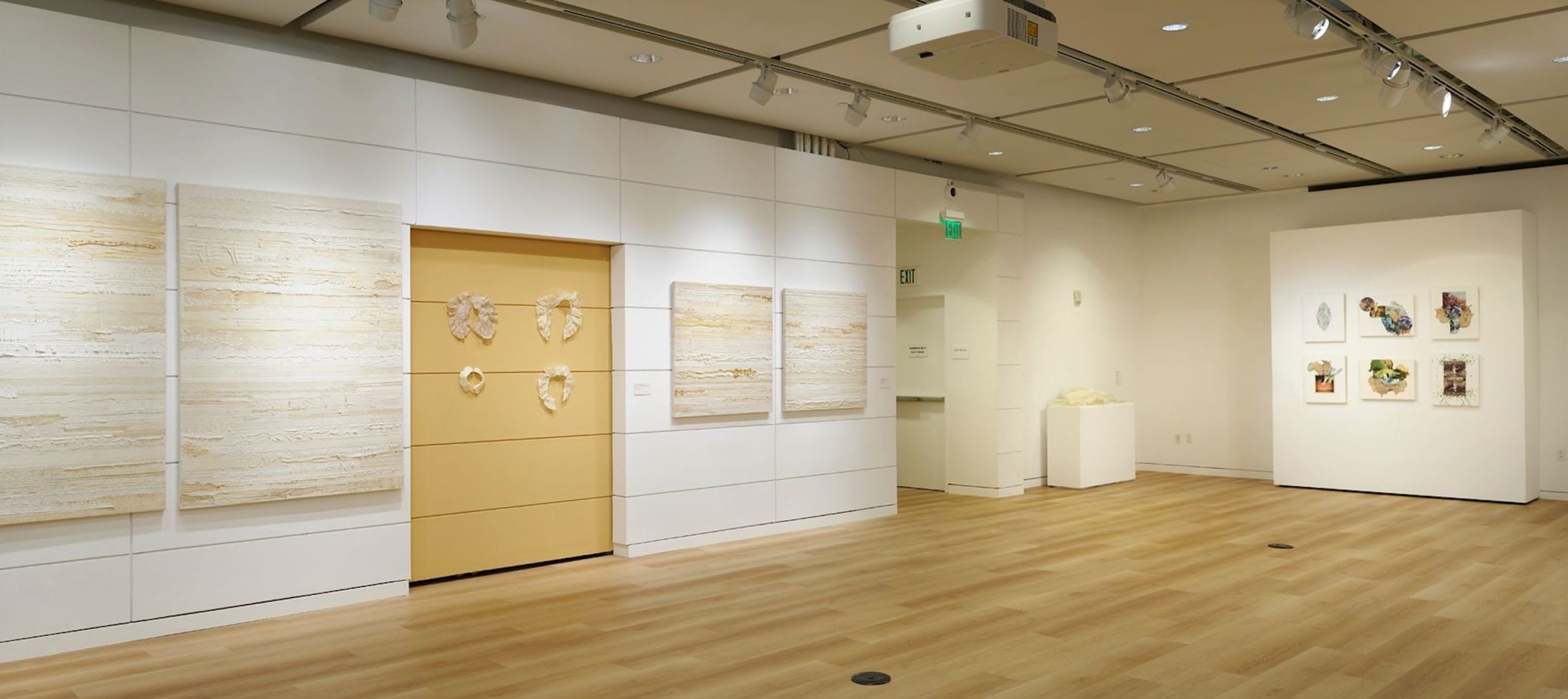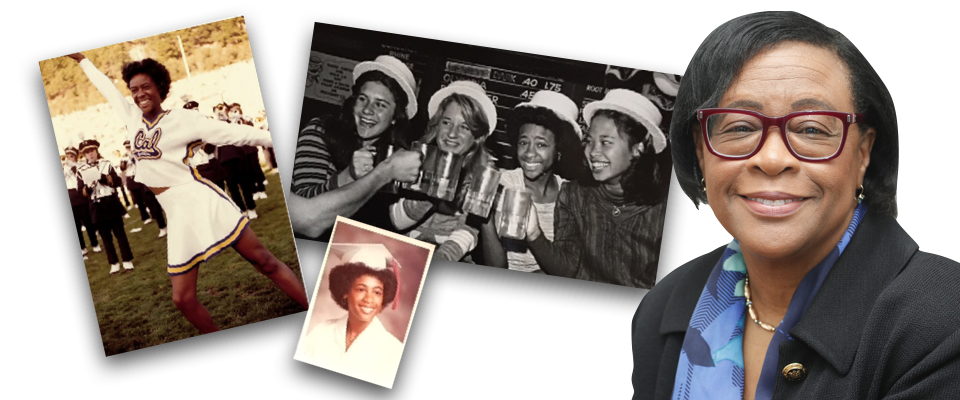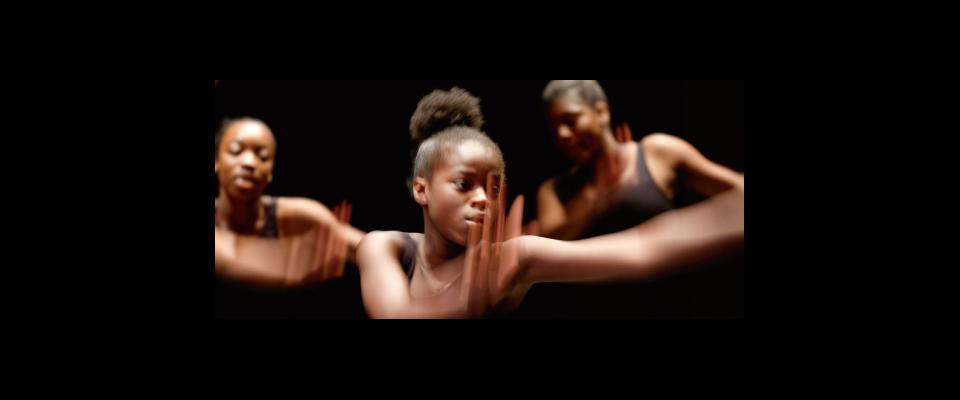A few years ago, artist Cynthia Brannvall spent the summer experimenting with creating a floor-to-ceiling cyclone of clothes, trying to push her textile work to sculpture. She didn’t really like the results—she had meant to convey female power with the cyclone, but instead it looked ghostly and fragile—and she worried she’d wasted the summer.
But then Donald Trump was elected president. Brannvall felt that women were vulnerable; she felt differently about the textile sculptures. She included some of them in her show, The Threads that Bind, at the Museum of the African Diaspora. In addition to her MoAD show, she also has a piece at the Arc Gallery in San Francisco, and in July, she will start a five month residency in the Cubberley Artist Studio Program in Palo Alto.
Brannvall, an art history professor at Foothill College in the Los Altos Hills, teaches a class on women in art. In the class, they talk about global suffragists, and she decided to honor two Black suffragists in her show, poet and lecturer Frances Ellen Watkins and civil rights activist Daisy Elizabeth Adams Lampkin. For those pieces, she took white 19th century blouses, boiling them for hours to remove stains, then stiffening them with resin and beeswax.
The exhibition gets its name from a central piece in the show: a map of the United States made from different pieces of fabric, mostly white and beige. Brannvall says once the idea to make this came to her, she couldn’t let it rest, studying multiple maps and making a big gap for the Mason Dixon line with long stitches between the South and the North.
“I always knew I wanted to do a map piece in my visual language that I had developed,” she said. “I was struck by the political divide, and it reminded me of the debates over slavery and the westward expansion era of this country, so I felt compelled to make that piece.”


In another piece in the show, Little Girls Birmingham, Brannvall used four dress collars for the little girls killed in the KKK’s bombing of a church in Birmingham, Alabama in 1963.
“Those collars evoke a particular era and a feeling of youth and innocence,” she said. “We all know that story, and I wanted to do something so we can revisit it in a way that helps us to register the youth of these girls.”
Most of the women in Brannvall’s family sewed, and some of her earliest memories involve sewing, practicing on two pieces of cardboard with holes punched in to sew them together.
Brannvall says her family dynamics had a lot of tension and animosity—her mother had a heroin addiction, so Brannvall spent a lot of time with her grandmother and aunt. Sewing together offered a kind of refuge for them.
“There were a lot of hard feelings around the behaviors that my mother was engaging in in her life, and we didn’t always get along, and there was lots of blame going around and lots of dysfunction,” Brannvall said. “But sewing was one of the few ways we could all be together—my mom and her sister and my grandma and myself. We could all be in the same space and no matter what was going on in the family dynamics, we could admire one another’s creativity and stitches.”

After high school, Brannvall went to work, first doing advertising for a movie theater, then delivering mail for the Post Office for a decade. She got married and moved to the Bay Area, where she worked as a massage therapist, a job that gave her time to take care of her daughter. After what she describes as a grueling divorce, and the death of both parents, Brannvall decided to go to college in her 30s. She started at Foothill, not taking any art classes, because she thought if she did, she wouldn’t take anything else. She considered transferring to San José State, but a teacher at Foothill suggested she go to Berkeley. Brannvall applied there and to Mills College, which accepted her with a scholarship, but she liked the large campus that UC Berkeley offered.
Brannvall says when she first went to college, she was interested in everything.
“You know when little kids are like ‘I’m going to be an astronaut, and I’m going to be president!’ I thought, ‘I’m going to be a writer and study political science and psychology!’ I wanted to do all these things. So art history was a really good fit because you’re able to use all those theoretical frameworks, and of course I loved art.”
Before Brannvall entered college, she had studied art on her own, working with people including a Russian painter and a retired Disney animator, and she decided to study fine art as well as art history at Berkeley. She had been painting landscapes and figures but at Berkeley, she changed her focus. She saw all the different modalities offered, such as wood, metal, and ceramics, and started to experiment, eventually landing on textiles, which felt familiar.
“Studying art history, I was aware the perspective of women was so absent. I started imaging these women, as I did in my family, this is what you do—you sit around and you make stuff,” she said. “I started thinking about women and their lack of visibility and voice in the history of art, and I became really interested in using textiles and fabric as a way of conjuring those spaces.”
Brannvall says she thinks of her work as idiosyncratic with ambiguity and tensions between fine art and craft, painting and sculpture, and past and present. She says she uses the old materials to make statements about contemporary issues, with the blouses evoking a different time and place and both the battle for women’s rights and the vulnerability of those rights.
“I felt like these pieces were powerful reminders that these rights we have are fragile. I felt like they were these entities almost like hovering and coming from the past,” she said. “I never imagined in a million years that Roe v. Wade would be threatened in my lifetime.”
There’s a reason so much of Brannvall’s work is in white. In a graduate seminar she took at Berkeley, the class had a conversation about a piece by Martin Puryear, saying that since he had decided to paint it black, it must be about race.
Brannvall thought about why this bothered her. She decided it was that Black artists were often asked to discuss how their work represented Black identity.
“It reduces the nuance and complexity of what Black identity and Black experience is,” she said. “If Robert Rauschenberg makes a white painting, nobody asks him what that tells us about the white race. I have enjoyed complicating that and flipping the script. What does it mean for a Black woman to work with white materials whose art is often addressing the Black experience?”





















